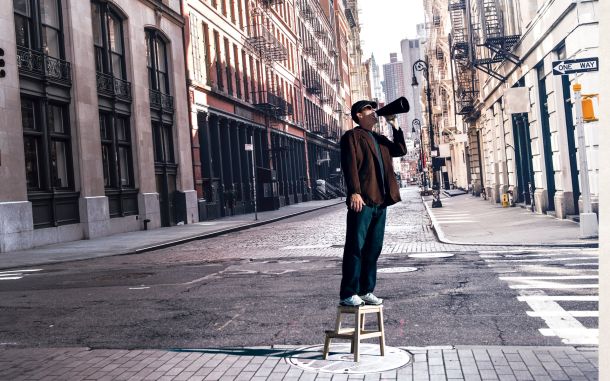What Are You “Working” On?

In This Article
-
The microwave lets me inquire about the variety of spilled content on its glass plate. The resonance frequency that initiates its rattling has been so unpredictably arbitrary that I started wondering whether it can operate as a time machine, opening intergalactic portals for the remainder of its life.
-
While your skills, aptitudes, and preferences lead you to a direction, stumbling over a temporary force field and choosing an incorrect direction will likely end with you losing your energy to your surroundings in the form of heat, frustration, waste, and desperation as you recalibrate with hopes that it is not late.
A rare, rainy day for drought-stricken San Jose, California, ushered a lot of wet students into my room at lunch time. I like to call my room “Mr. B’s Restaurant” due to the diverse scents, flavors, and the vibrant psyche therein. The microwave lets me inquire about the variety of spilled content on its glass plate. The resonance frequency that initiates its rattling has been so unpredictably arbitrary that I started wondering whether it can operate as a time machine, opening intergalactic portals for the remainder of its life.
To be more realistic though, I once told my hunger-driven students that they can use this microwave as a means to roughly measure the speed of light (when you overburn your hardened lunch in it while the rotating platform does not do its job). Many are shocked to hear this: how can the least demanding culinary tool teach them something scientific? Physics is entirely interesting when we show its living aspects and take it out of the realm of equations and boring lectures. Yet, still, some students got away from it merely because it is a science subject and that they are not self-allegedly science persons. So, could a physics teacher genuinely put physics on a student’s plate as something edible, relatable, or even palatable? Maybe if they see that physics encroaches into every aspect of their lives—even social studies.
It seems worth trying it.
During lunch on that rainy day, I overheard two students talking fervently about many topics, like whether pizza with pineapples is edible, the new sequels to games they’ve been playing, etc. One sentence stood out and reverberated across my physics-molded neuron cells: “I am working on…”. This sentence opens the door to making physics, and especially the concept “work” more approachable, especially for those students lacking a solid foundation of physics in their day-to-day lives. I pursued this opening, struggling to explain it on the board. Looking at my baffled students, I thought about the hidden, dormant, emerging, flowing, oozing, and bursting mental potentials and realized that they have the power to change the flow of things around them. These thoughts trickled out, and Mr. B started his serenade for physics.
In physics, “work” is done when a force causes an object to displace in the applied force’s direction.
I imagined my students’ question: “So, Mr. B! When you were saying the definition of “work,” you were literally pushing the wall as if to break into the biology room next door. So, since the wall did not move, does it mean that you didn't do any work?”
“Yes, it does, for I could not break into Mr. Q’s room! If I could, I would have to talk about this with Mr. Principal rather than you!”
Work in physics is the way of transferring energy to or from something. As “sharing is caring,” to take care of other systems, you have to move towards them, which is not like mere empathy; no, it’s actually changing your position, be it leaving your comfort zone or walking to help.
Getting more inspired by the baffled looks of my students, I felt like I had the upper hand. I targeted my words to the receivers in their hearts: “Though of different and similar types, all of you have huge potentials and energies in you. You have levels of forces you can apply to various hobbies, goals, or destinations. These treasures of skills, potentialities, abilities, and talents only surface when they do ‘work’ and transfer ‘energy’ to other beings or entities. Life is going on with its glorious energy transfers. The Sun takes care of plants; plants have appointments with animals, and humans have links with all, and all with each other. While this is the scene, why don’t we get out of our comfort zones, displace, move, and approach our destinations? Nature calls for motion, the joy of movement, and constantly using energy to grow. This notion is embodied in the formula Work Done = Force Applied x Displacement. Yes, ‘may the Force be with you!’ But this is not a sufficient invocation—albeit a nice one that misses the ‘motion’ part.
“Force has to be lucky enough to be accompanied by the directed motion; then, it can gracefully transfer energy and act in the way it is meant to. You might need to use your force in the correct direction. While your skills, aptitudes, and preferences lead you to a direction, stumbling over a temporary force field and choosing an incorrect direction will likely end with you losing your energy to your surroundings in the form of heat, frustration, waste, and desperation as you recalibrate with hopes that it is not late. A scalar is what we call a quantity with no direction, size, or amount. If you want to be practical and go to a grocery store, asking ‘I want 2 pounds of potatoes in the east direction,’ violates the boundaries of the use of scalars; you might receive a bag of potatoes with a considerable amount of velocity in a given direction—that is to say, to your face. So, we have to know where to use proper scalars in physics, just like we have to show proper and appropriate manners, skills, and powers at correct places and times.”
Thus, Mr. B ends his speech by saying, “Know your potentials; do not compare them with others’. The work done in physics is known by the product of the force you exert with the distance taken along the force. Calibrate your goals and do ‘work.’ If you mistakenly think that you are not smart, think about the fact that you can still do more work than those who are allegedly ‘smarter’ yet do not move.”








